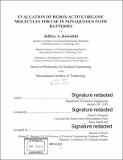Evaluation of redox active organic molecules for use in nonaqueous flow batteries
Author(s)
Kowalski, Jeffrey A.(Jeffrey Adam)
Download1121594514-MIT.pdf (29.77Mb)
Other Contributors
Massachusetts Institute of Technology. Department of Chemical Engineering.
Advisor
Fikile R. Brushett.
Terms of use
Metadata
Show full item recordAbstract
Technical advances in grid energy storage are of critical importance to facilitate the integration of intermittent renewables and improve the efficiency, reliability, and resiliency of the existing fossil fuel infrastructure. Redox flow batteries (RFBs) are an electrochemical technology well suited for stationary energy storage due to independently addressable power and energy components, simplified manufacturing, and long operating lifetimes. While state-of-the-art RFBs utilizing transition metal salts in acidic, aqueous electrolytes have found some success, further cost reductions are needed, motivating research into organic redox couples dissolved in nonaqueous electrolytes. Nonaqueous electrolytes offer the advantages of wider electrochemical stability windows and compatibility with a broader palette of charge-storage materials. Redox active organic molecules can be modified through targeted functionalization to impart desired properties and consist of earth abundant elements, which may enable scalable, low cost synthesis routes. This thesis focuses on organic molecules intended for use as positive active materials in nonaqueous RFBs. The two redox active cores examined are substituted dialkoxybenzenes and phenothiazines. Both molecules served as learning platforms and were systematically functionalized, with one or more substituent groups, to elucidate structure-function relationships with particular emphasis on increasing solubility, gravimetric capacity, and redox potential. Initial efforts focused on the modification of 2,5-di-tert-butyl-1,4-bis(2-methoxyethoxy)benzene through subtractive engineering to identify stable minimal structures. Next, the impact of halidization was examined leading to a 300 - 400 mV increase in redox potential but severe reductions in cyclability. Due to limitations of the stability of the substituted dialkoxybenzenes, subsequent efforts were undertaken using N-ethylphenothiazine. Through an iterative approach of targeted functionalization, (1) solubility was increased and (2) the second electron transfer was stabilized resulting in redox active electrolytes with a volumetric charge storage capacity approaching the range envisioned for economically viable RFBs. While the moderate stability of the substituted dialkoxybenzenes appears to limit their applicability as active materials, they have utility as model compounds suitable for supporting the development and standardization of testing protocols for RFBs. As organic materials are emergent for RFB applications, standardized testing protocols and benchmarking techniques are not established, frustrating quantitative comparisons between new materials. To this end, new electrochemical methods are introduced to evaluate and report the stability of redox active materials at dilute conditions, using bulk electrolysis cycling, and at concentrated conditions, using time-dependent microelectrode voltammetry, which are validated using dialkoxybenzenes.
Description
Thesis: Ph. D., Massachusetts Institute of Technology, Department of Chemical Engineering, 2019 Cataloged from PDF version of thesis. Includes bibliographical references (pages 261-278).
Date issued
2019Department
Massachusetts Institute of Technology. Department of Chemical EngineeringPublisher
Massachusetts Institute of Technology
Keywords
Chemical Engineering.